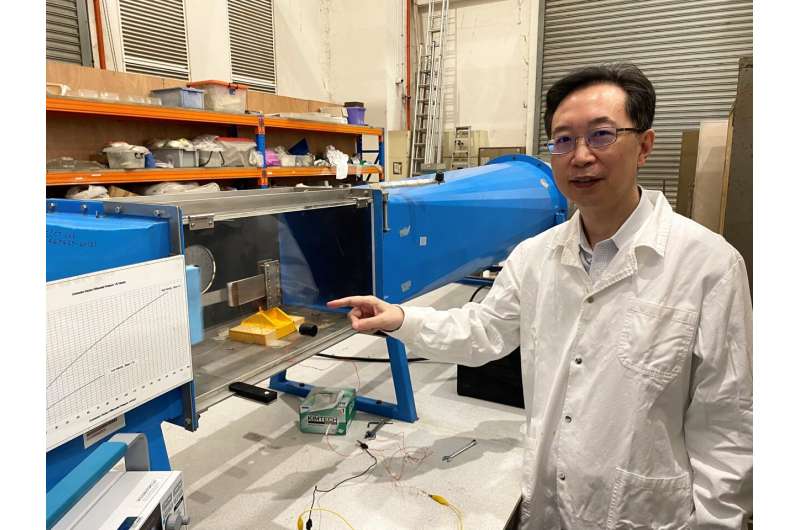Inexpensive device that can harvest energy from a light breeze and store it as electricity

Scientists from Nanyang Technological University, Singapore (NTU Singapore) have developed a low-cost device that can harness energy from wind as gentle as a light breeze and store it as electricity.
When exposed to winds with a velocity as low as 2 meters per second (m/s), the device can produce a voltage of three volts and generate electricity power of up to 290 microwatts, which is sufficient to power a commercial sensor device and for it to also send the data to a mobile phone or a computer.
The light and durable device, called a wind harvester, also diverts any electricity that is not in use to a battery, where it can be stored to power devices in the absence of wind.
The scientists say their invention has the potential to replace batteries in powering light emitting diode (LED) lights and structural health monitoring sensors. Those are used on urban structures, such as bridges and skyscrapers, to monitor their structural health, alerting engineers to issues such as instabilities or physical damage.
Measuring only 15 centimeters by 20 centimeters, the device can easily be mounted on the sides of buildings, and would be ideal for urban environments, such as Singaporean suburbs, where average wind speeds are less than 2.5 m/s, outside of thunderstorms.
The findings were published in the journal Mechanical Systems and Signal Processing in September.
Professor Yang Yaowen, a structural engineer from NTU’s School of Civil and Environmental Engineering (CEE), who led the project, said, “As a renewable and clean energy source, wind power generation has attracted extensive research attention. Our research aims to tackle the lack of a small-scale energy harvester for more targeted functions, such as to power smaller sensors and electronic devices.
“The device we developed also serves as a potential alternative to smaller lithium-ion batteries, as our wind harvester is self-sufficient and would only require occasional maintenance, and does not use heavy metals, which if not disposed of properly, could cause environmental problems.”
The innovation has received interest from the industry. The NTU research team is also working toward commercializing their invention.
The study, which presents an innovation that could help cut down on electronic waste and find alternative sources for energy, reflects NTU’s commitment to mitigate our impact on the environment, which is one of four humanity’s grand challenges that the University seeks to address through its NTU 2025 strategic plan.
Riding the wind
The device was developed to harness efficient wind energy at low cost and with low wear and tear. Its body is made of fiber epoxy, a highly durable polymer, with the main attachment that interacts with the wind and is made of inexpensive materials, such as copper, aluminum foil, and polytetrafluoroethylene, a durable polymer that is also known as Teflon.
Due to the dynamic design of its structure, when the harvester is exposed to wind flow, it begins to vibrate, causing its plate to approach to and depart from the stopper. This causes charges to be formed on the film, and an electrical current is formed as they flow from the aluminum foil to the copper film.
In laboratory tests, the NTU-developed harvester could power 40 LEDs consistently at a wind speed of 4 m/s. It could also trigger a sensor device, and power it sufficiently to send the room temperature information to a mobile phone wirelessly.
This demonstrated that the harvester could not only generate electricity to consistently power a device, but that it could store excess charge that was sufficient to keep the device powered for an extended period in the absence of wind.
Prof. Yang added, “Wind energy is a source of renewable energy. It does not contaminate, it is inexhaustible and reduces the use of fossil fuels, which are the origin of greenhouse gasses that cause global warming. Our invention has been shown to effectively harness this sustainable source of energy to charge batteries and light LEDs, demonstrating its potential as an energy generator to power the next generation of electronics, which are smaller in size and require less power.”
The NTU team will be conducting further research to further improve the energy storage functions of their device, as well as experiment with different materials to improve its output power. The research team is also in the process of filing for a patent with NTUitive, NTU’s innovation and enterprise company.
World’s largest flow battery energy storage station connected to grid
Chaoyang Zhao et al, A cantilever-type vibro-impact triboelectric energy harvester for wind energy harvesting, Mechanical Systems and Signal Processing (2022). DOI: 10.1016/j.ymssp.2022.109185
Citation:
Inexpensive device that can harvest energy from a light breeze and store it as electricity (2022, October 6)
retrieved 6 October 2022
from https://techxplore.com/news/2022-10-inexpensive-device-harvest-energy-breeze.html
This document is subject to copyright. Apart from any fair dealing for the purpose of private study or research, no
part may be reproduced without the written permission. The content is provided for information purposes only.
For all the latest Technology News Click Here
For the latest news and updates, follow us on Google News.

